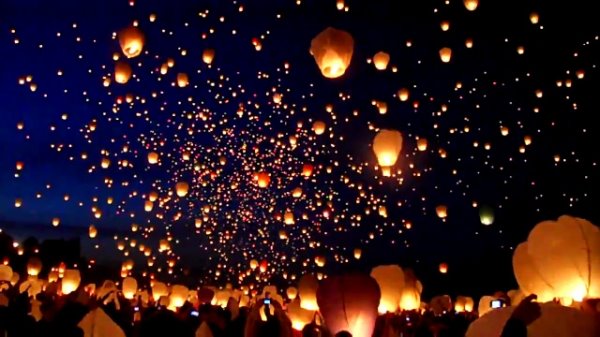


FLOATING SHINY KNOT
Google street view
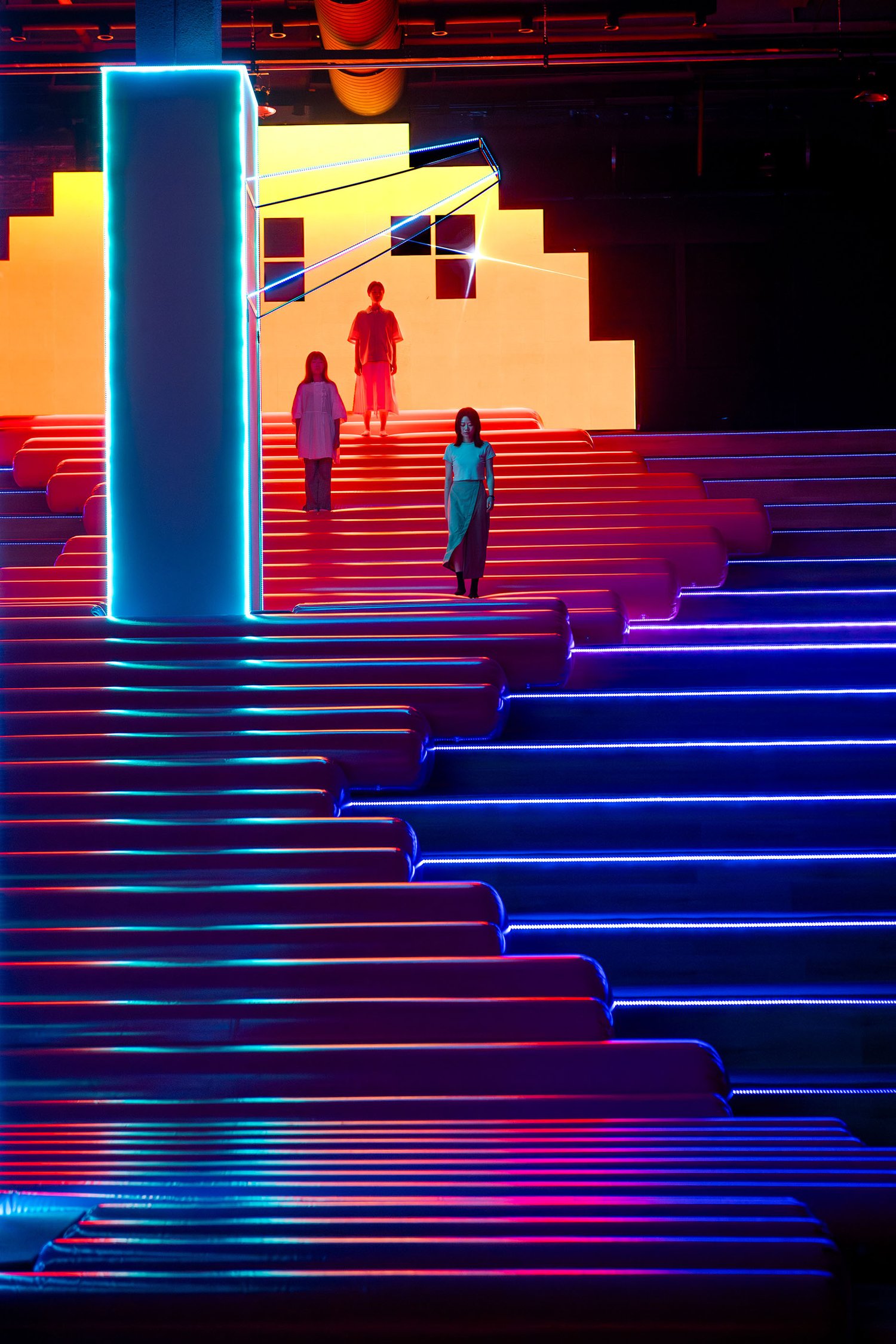
ENESS
Modern Guru
Modern Guru is a translucent ovoid with four huge digital eyes, floating above a ceremonial ring of LEDs. From his mouth flows a ream of absurdist messages, and in a statement about the true nature of lived experience, a new message is delivered when visitors take a photo of Modern Guru – a missive produced only for those who seek to photograph life rather than live the moment. This immersive new media art installation uses the intersection of art and technology to explore modern paths to happiness through unique interactions with characters along a mystical journey of discovery. Visitors are asked to commit to the path – a tight and winding trail with subtle points of connection along the way – a glowing landscape of oversized, whimsical mountains that chant incantations and blink innocently from digital eyes.
Having communed with the Guru, visitors then weave their way back through this warped and strange world full of illusions and delusions, perceptions and deceptions, all the while bathing in luminescent light; embracing big, gentle forms; and following their own path up the pink tongue staircase to meet the one who oversees the whole fantastic dominion, the Sun God.

QUBIT AI: Leilanni Todd
Floating
FILE 2024 | Aesthetic Synthetics
International Electronic Language Festival
Leilanni Todd – Floating – United States
Floating explores the concept of surrendering and freeing oneself by allowing oneself to float, symbolizing overcoming adversity and mastering self-confidence. Inspired by her grandmother’s journey to overcome her fear of water through swimming, the work uses water and sea creatures as symbols of resilience and transformation. The personal narrative behind the work adds depth to its exploration of overcoming fears and discovering inner strength.
Bio
Leilanni Todd is an award-winning creative director with extensive experience in advertising, fashion and new media. Originally from Toronto and now based in New York, she harmoniously integrates art, technology and culture into her work. Through her FLOAM WORLD platform, Leilanni creates surreal narratives, reimagines traditional norms in fashion and advertising, and addresses complex human issues with humor and creativity.

DORETTE STURM
FILE SAO PAULO 2017
THE BREATHING CLOUD
“The Breathing Cloud” is a monumental floating organism. The work transforms a space by its motion, light, and rhythmic breathing. With this light art the phrase “let a room come to life” gets a new meaning. The clouds skin looks fragile and soft, and the movements are rhythmic, yet random, so the whole room feels like a living being. The technology is designed so that the strong LED modules and the mechanism support the pervasive breathing. It gets physically bigger and smaller and embraces with its bright light space.

GK TECH
GK-0G – Floating Habitat
The GK-0G is the minimum size prototype of a scalable floating installation.
It is composed of five tetrahedral frameworks, its basic structural elements, arranged like sections of an orange. It is enveloped with a cover which acts as an interface between internal and external environments.Flotation is gained by tetra balloons inside the tetrahedral frameworks. As the only choice at this moment, helium is encapsulated inside the tetra balloons made of an impermeable film.This model is meant to verify that it can float and move in the air. It is considered that different degrees of flotation can be gained by combining tetra balloons in different ways.
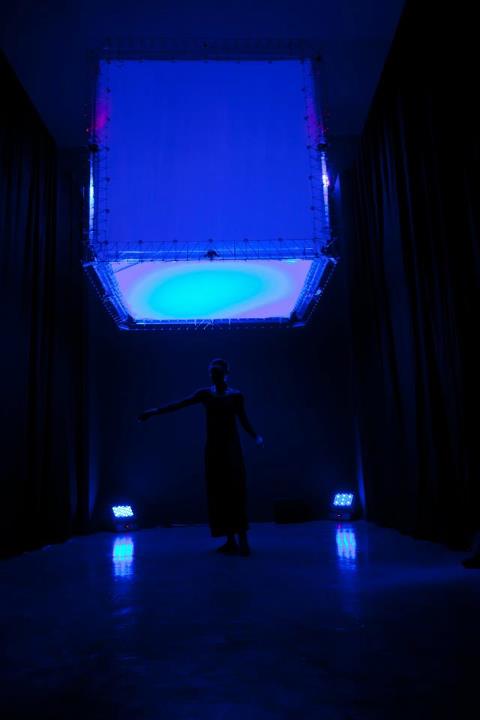
NXI GESTATIO: NICOLAS REEVES, DAVID ST-ONGE & GHISLAINE DOTÉ
Paradoxal Sleep
File Festival
O projeto “Paradoxal Sleep” integra uma série de obras na qual grandes cubos robotizados, medindo 2,25 m3, funcionam como estruturas flutuantes usadas como plataformas para vários projetos multimídia e performances. No FILE 2012, a equipe da NXI GESTATIO apresentará um único cubo que irá se mover nos espaços expositivos. O cubo reajustará constantemente sua posição medindo a distância entre as paredes ao redor.
.
The “Paradoxal Sleep” project integrates a series of works in which large robotic cubes, measuring 2.25 m3, function as floating structures used as platforms for various multimedia projects and performances. At FILE 2012, the NXI GESTATIO team will present a single cube that will move in the exhibition spaces. The cube will constantly readjust its position by measuring the distance between the surrounding walls.

VINCENT LEROY
TOKYO METACLOUD
.
Vincent Leroy onthult ‘Tokyo Metacloud’, een gigantische zwevende wolk die door de straten van de japanse metropool trekt. De installatie, bestaande uit dunne gebogen bladen, speelt met de balans tussen materiaal, lucht en transparantie om een indruk van extreme lichtheid te creëren. Nogmaals, het poëtische en contemplatieve universum van Leroy maakt kijkers los van de echte wereld en nodigt hen uit om te genieten van een meeslepende, dromerige ervaring.
.
Vincent Leroy unveils ‘Tokyo Metacloud’, a gigantic floating cloud that sweeps through the streets of the Japanese metropolis. The installation, consisting of thin curved blades, plays with the balance between material, air and transparency to create an impression of extreme lightness. Again, Leroy’s poetic and contemplative universe detaches viewers from the real world and invites them to enjoy an immersive, dreamlike experience.
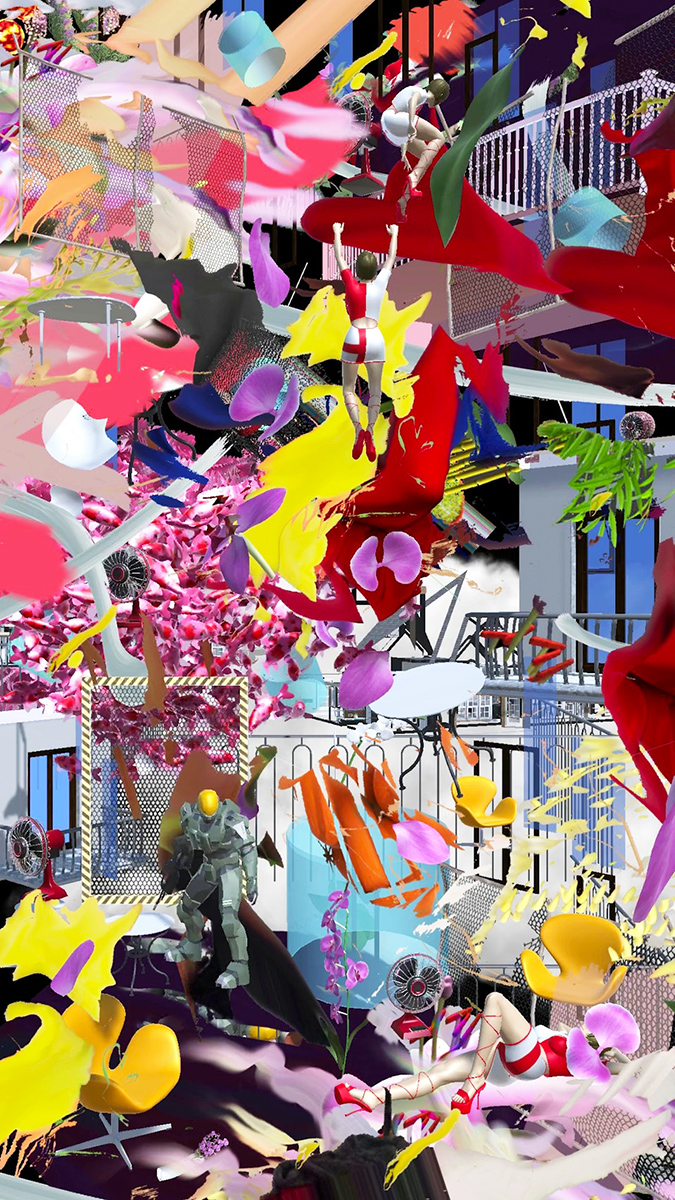
Cassie Mcquater
Halo
In these six animated paintings presented as a single channel video, the artist reenacts situations and motifs from the first-person shooter series Halo and the erotic videogame Dream Stripper. Conceived as a dynamic, virtual collage, HALO shows short stock animation loops of characters dying over and over, with koi, dining chairs, asteroids, guns, flowers, torches, pinball machines, candles, and discarded pillows floating around them, creating a hypnotic motion.

UJOO LIMHEEYOUNG
Machine Tree
Machine with Tree is a kinetic sculpture combining dead trees with metal machinery. It is designed to use the object’s center of gravity to achieve a movement where the tree appears to float in midair. In Machine with Tree, a dead tree is placed at the end of a long, sharp rod on the machine. The tree slowly moves back and forth with the machine’s movements, as though floating in midair. Through its creation of artificial, bizarre movements controlled by machinery, it illustrates a melancholy contemplation of the strange and contradictory things woven together by our reality.

Robert Breer
Float
The Floats – or floating sculptures – that Robert Breer took up producing again at the end of the 1990s, emerged in 1965. The word “float” meaning something floating – a marker, fishing float or buoy – and which also describes those carnival vehicles whose pretend wheels give them the appearance of floating above the tarmac, enabled Robert Breer to apply this principle to works of a new genre. Primary shapes, neutral colours and, for the most recent, an industrial aspect, the Floats were then made with polystyrene, foam, painted plywood, and, more latterly, out of fibreglass. At first glance, these simple structures appear immobile. In fact, they are moving, imperceptibly, within the space they inhabit. Motorised and on mini-rollers – which raise them slightly above ground, giving them an air of weightlessness – they glide unbeknown to the visitor, following random paths that are interrupted by the slightest obstacle that they encounter.

Chris Cheung
No Longer Write – Mochiji
Powered by artificial intelligence’s Generative Adversarial Networks (GANs), the collected works from ancient Chinese Calligraphers, including Wang Xizhi, Dong Qichang, Rao Jie, Su Shi, Huang Tingjian, Wang Yangming, as input data for deep learning. Strokes, scripts and style of the masters are blended and visualized in “Mochiji”, a Chinese literature work paying tribute to Wang Xizhi. Wang is famous for his hard work in the pursuit of Chinese calligraphy. He kept practicing calligraphy near the pond and eventually turned the pond for brush washing into an ink pond (Mochi). The artwork provides a platform for participants to write and record their handwriting. After a participant finished writing the randomly assigned script from “Mochiji”, the input process is completed and the deep learning process will begin. The newly collected scripts will be displayed on the screen like floating ink on the pond, and slowly merge with other collected data to present a newly learnt script. The ink pond imitates process of machine learning, which observes, compares and filters inputs through layers of image and text, to form a modern edition of “Mochiji”.
.
不再写 – Mochiji
以人工智能的生成对抗网络(GANs)为动力,将王羲之、董其昌、饶捷、苏轼、黄廷健、王阳明等中国古代书法家的作品作为深度学习的输入数据。向王羲之致敬的中国文学作品《麻糬》,将大师的笔触、文字、风格融为一体,形象化。王先生以对中国书法的刻苦钻研而著称。他一直在池塘边练习书法,最终把洗笔池变成了墨池(麻糬)。艺术作品为参与者提供了一个书写和记录他们笔迹的平台。参与者完成“Mochiji”中随机分配的脚本后,输入过程完成,深度学习过程将开始。新收集到的脚本会像池塘上的浮墨一样显示在屏幕上,并与其他收集到的数据慢慢融合,呈现出新学到的脚本。墨池模仿机器学习的过程,通过图像和文本的层层观察、比较和过滤输入,形成现代版的“年糕”。

kenneth snelson
Needle Tower
“Inspired by architect Buckminster Fuller’s interest in the geometry of structure, Snelson’s experiments led to a prototype for a “floating compression structure.” Fuller subsequently credited Snelson with having invented a new structural principle which the architect named tensegrity, a contraction of the words tension and integrity.
These investigations into the physical properties of structure became more fully realized as an art form beginning in the 1950s. Snelson created sculptures consisting of tubes and cables. Cylinders of steel seemingly dance through space in defiance of gravity, yet it is the structural competition between tension and compression which underlies their construction. Snelson finds beauty in bringing these forces of nature into balance: the rigid compression tubes pushing outward, the flexible tension cables pulling inward. His sculptures would maintain their structural integrity beyond gravity, in the vacuum of outer space.” Joelle Burrows

Daan Roosegaarde
Windvogel
WINDVOGEL are energy generating kites which create up to 100 kW and can supply about 200 households with green energy. Floating in the air, the smart kites move around and are connected with a cable to a ground station. This push and pull of the cable transforms into electricity, like the dynamo of a bicycle.
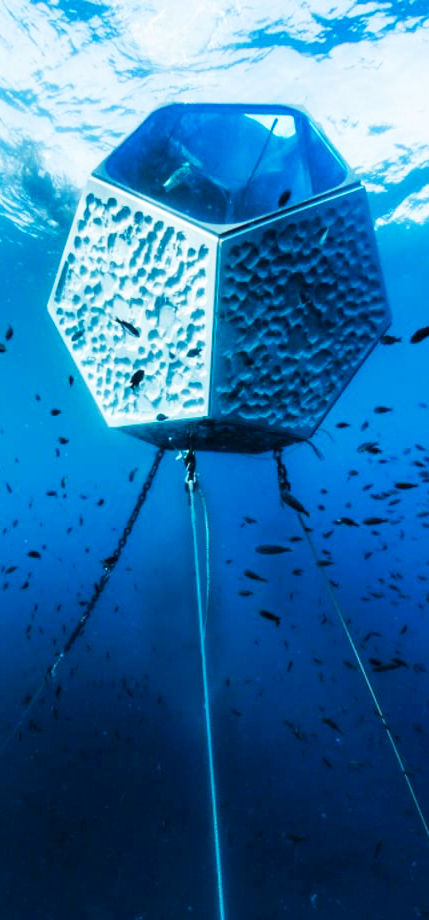
DOUG AITKEN
Underwater Pavilions
Underwater Pavilions is artist Doug Aitken’s large-scale installation produced by Parley for the Oceans and presented in partnership with The Museum of Contemporary Art, Los Angeles (MOCA). The work consists of three temporary underwater sculptures, floating beneath the ocean’s surface that swimmers, snorkelers, and scuba divers swim through and experience. Geometric in design, the sculptures create underwater spaces synthesizing art and science as they are constructed with carefully researched materials and will be moored to the ocean floor. Part of each structure is mirrored to reflect the underwater seascape and create a kaleidoscopic observatory for the viewer, while other surfaces are rough and rock-like. The environments created by the sculptures will constantly change with the currents and the time of day, focusing the attention of the viewer on the rhythm of the ocean and its life cycles.

Thom Kubli & Prof. Hiroshi Ishii
Orbiting
Orbiting features floating, machine-generated sculptures. The 3-D-printed objects — made from an ultra-light material — are injected with helium and released into the air as they become buoyant. As the ascending sculptures rise toward the ceiling, they enter the flow of a thermal stream and begin their gentle orbit. While floating, these ethereal objects participate in a continuously changing series of celestial movements.

Kohei Nawa
Throne
This work attempts to express that premonition as an immense “floating vacant throne”. If instances of power and authority have ruled since ancient times, and the pyramids provide one example—we must ask what the future will hold. Created with reference to the forms of festival floats and portable shrines that appear in the rituals and festivities of the East, the sculpture fuses today’s 3D modeling techniques with gold leaf applications that date back to ancient Egypt. In the frontal center is an empty room, space enough for a 2 to 3-year-old child to sit, suggesting that the new intelligence is still in a young state. Shining, spherical mirrors placed at the center in front and back. Made of platinum foil, they represent “the eyes overlooking the world”, where the frontal one faces the future and the back reflects into the past.

Joanie Lemercier
Brume
Brume is a series of works and installations by Joanie Lemercier, using a custom made device made of atomized water. Joanie frees his work from the screen and usual physical devices. He is using space and immateriality as a canvas, creating a mid air floating projection feeling. Thanks to this volumetric tool, he is modifying our frontal relationship with screen and allowing new interaction between the viewer and the projected image. Joanie Lemercier is still exploring the possibilities of this new medium with a series of experiences and chapters, questioning our view of reality. In his work, Joanie is researching timeless subjects like light, matter, geometry. With Brume, he is also interested in the link between water and light.
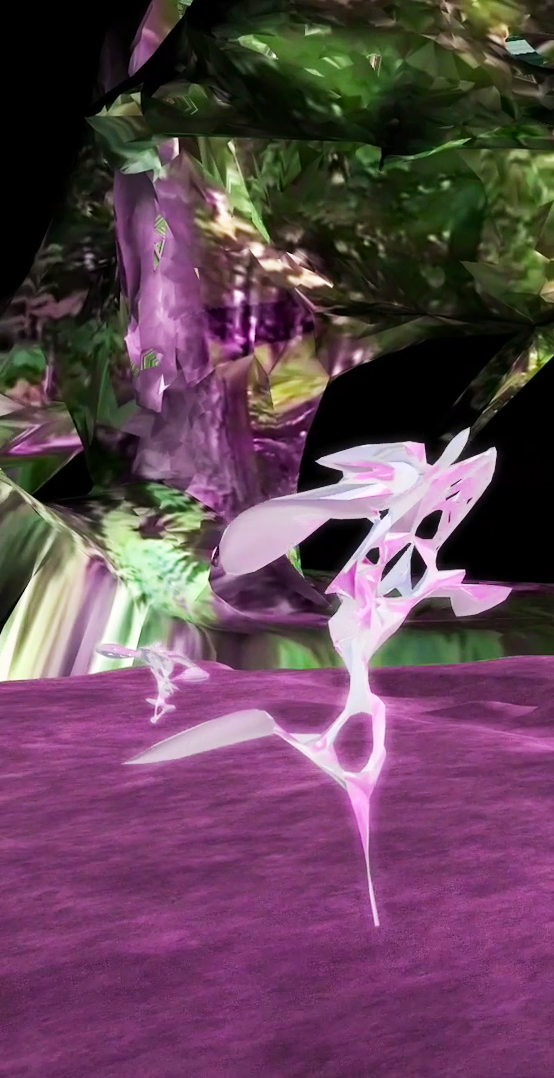
Isabella Münnich
Immersed Garden
Immersed Garden is in its true sense a sunken world. Floating bodiless in an underwater garden, natural sounds guide you through an immersive surrounding, somewhere between calming and irritating, natural and artificial. It is a playful exploration of the individual conception of safety and confusion and a personal approach to aesthetic references to habits of introspection and retreat in digital environments. It was created by fusing different digital processes like photogrammetry of selected natural places around Karlsruhe and field recordings in a local natural reserve. Underwater videos hybridize with 3D scans of trees and plants while invisible frogs are croaking and humming birds are buzzing by synthetic flowers. The artistic aim was to explore the personal perception of calming and irritating, playing with the concept of immaterialness and attentiveness. The artwork creates aesthetic references to philosophical and scientific theories of introspection and identity.
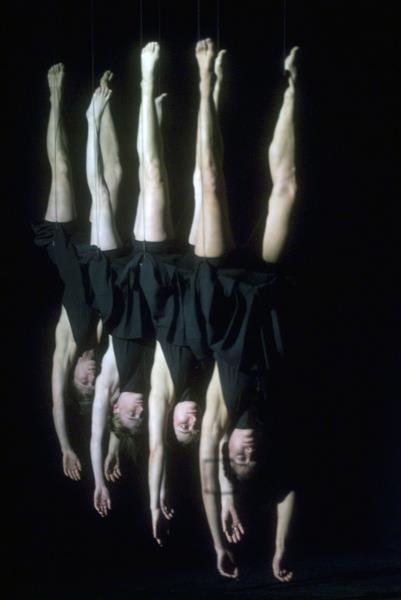
KRIS VERDONCK
I / II / III / IIII
In I/II/III/IIII, choreographer and visual artist Kris Verdonck transforms the stage into a life-size dollhouse. Four female ICK-dancers – not unlike marionettes – are floating in mid-air, suspended from a huge machine. A solo, a duet, a trio and a quartet follow one another in this choreography of identical movements. A game of surrendering to the machine and at the same time, searching for control. The images evoked by I/II/III/IIII are confusing and ambiguous: the dancers almost look like graceful, fragile swans … but they also remind us of animal carcasses being dragged along, floating angels, falling human bodies and everything in between.

Mathias Gartner & Vera Tolazzi
THE TRANSPARENCY OF RANDOMNESS
“The Transparency of Randomness” gives insight into the world of randomness. In this interactive installation, visitors can directly experience the significance of the complex interplay of randomness and stochastics in current mathematical and physical research. 27 transparent boxes, floating in space, continuously generate random numbers by using the well-known medium of the dice.The process of random number generation is influenced by the complexity of nature and its structures, using a variety of natural materials. The ensemble of all generated random numbers forms the basis of a real-time calculation and comprehensibly demonstrates the impressive role in scientific research.
Clouds Architecture Office
AVATAR X Lab
The project is a partnership between ANA Holdings Inc. and Japan Aerospace Exploration Agency (JAXA); a part of AVATAR X, a collaborative program for the advancement of space exploration and development. ANA and JAXA are both experts at launching vehicles into the atmosphere, the feeling of suspension or ‘being in the air’ is natural for both entities. The AVATAR X Lab Building is designed as a suspended building floating above a moon-like crater. The multi-story structure floats eighteen meters above the crater bottom, and is accessible by a bridge. When astronauts board a spacecraft they cross a bridge; when we board a plane we walk across a jet bridge between the terminal and airplane. This is our last contact with familiar ground before taking off for someplace new. The suspended building embodies this crossing of thresholds: after passing over the bridge you are transported to a new place, the AVATAR X Lab Building, where technological innovation will change how we see the world.
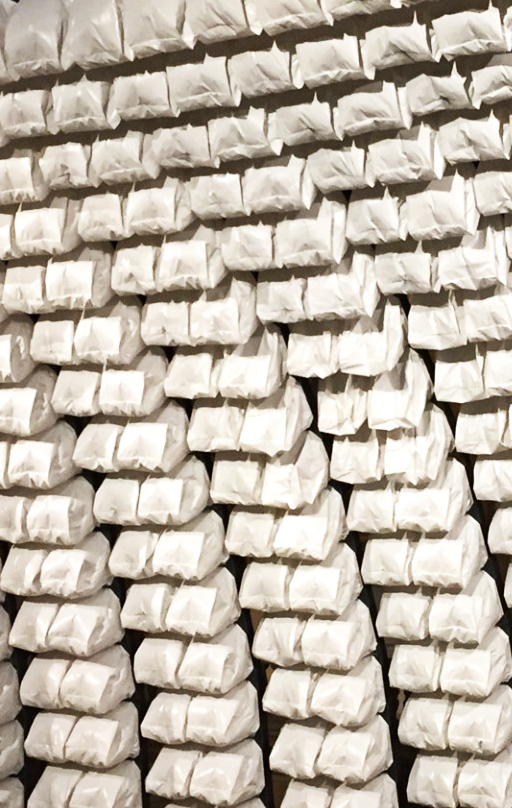
NILS VÖLKER
Two Hundred and Seventy
Through the combination of an everyday material with precise technology the mixed media installation fills the whole columned hall from the 19th century with its fluid movement and peculiar sound. Concavely arranged and floating above the spectators heads the form of the artwork seems to pass the skylight like the sun’s rays. Subdivided into nine columns, the nearly 70 square metres large piece of art follows a site-specific choreography determined by a program. Its moving surface is made from 270 white garbage bags, being inflated and deflated. In this way shapes and the boundaries of the installation itself start to dissolve. “Two Hundred and Seventy“ is the first installation with an undisguised view behind the scenes and onto the origin of the wavelike and organic movement: 1080 fans, lots of cables and 45 circuit boards
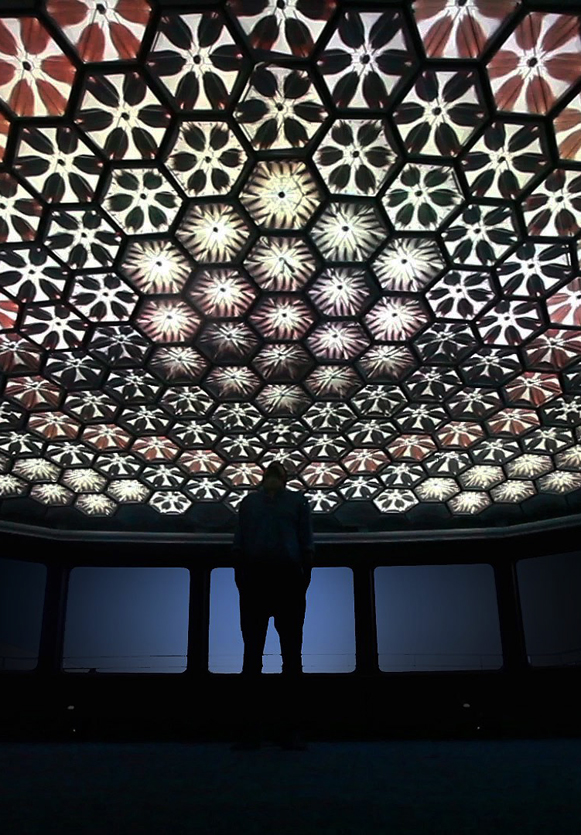
TUNDRA
My Whale
There is an impressive space at the front of the ship, with panoramic windshield and hexagonal pattern on the vaulted ceiling, remained from the 80-s, the time, when “Brusov” was constructed in Austria. Standing there gives you the feeling of floating through the reflections of the Krymsky bridge lights on the river, inside a giant whale head. Looking through its eyes, listening to its songs that flow across the brain made of hexagonal cells by the wires hanging down here and there.
With some light and sound we brought this whale to life.
Each piece of the projection onto the cells was cloned from the previous one with a random changes. So each cell behaved differently, pulsating to the rythm of the whale songs. To interract with the whale the visitor could place the phone screen above the black box in the center of the room.

Navid Navab
Aquaphoneia
Aquaphoneia is an alchemical installation centred around the poiesis of time and transmutation of voice into matter. A large horn floating mid space echoes the ghosts of Edison, Bell, and Berliner’s machines. But unlike early recording, herding sound energy to etch pressure patterns in solid matter, this odd assemblage transmutes voice into water and water into air. Disembodied voices abandon their sources to cross the event horizon of the horn. Estranged, the schizo-phone falls into the narrow depths of the bell, squeezed into spatiotemporal infinity, calcinated, liquified and released: The aqueous voice then flows into three alchemical chambers where inner time is surrendered to the tempi of matter: unbound, yet lucid and sound.

robert seidel
Vitreous
The nine virtual sculptures underlying vitreous resulted from experimental setups by Robert Seidel for generating three-dimensional clusters of fibrous refractions, as well as the gravitational lensing of different volumetric and chromatic densities. Singular elements gravitate towards each other, accumulating in a gigantic sculptural system, where each entity exists with its own visual axis and vanishing point. The impalpable luminous formations create prismatic interactions between the ridges and plateaux of the main colours floating in front of the infinite violet background.

MARIN SAWA
Марин Савва
مارين سوا
Algaerium
Algaerium is an in-vitro aesthetic photosynthesis system of microalgae for spatial installation of algal biotechnology in the urban environment. As a collective family, each member of Algaerium represents an urban bio-repository, floating biota, in which to preserve the microorganisms for their future biotechnological use such as bio-energy. Through displacement into the urban environment, Algaerium re-contextualises the sterile environment of the algae culture laboratory. I have incorporated and manipulated the endogenous yet ‘re-programmable’ biological processes of photosynthesis and bioluminescence.



Vincent Leroy
Floating Lens
The combination of movement and the reflections of the fresnel lenses, provide an interesting visual experience. When used on the rooftops of Paris, the Haussmanian roofs of the city seem to be seen through a dream. The wind on the lenses lightly distort the surroundings, creating a dream-like environment. Once again, the subtle mix of simple technology and poetic interpretation detach the conscious mind of reality. Leroy compares his project to an intriguing game of fluidity: “everything seems to breathe: no beginning, no end, just a stream.”
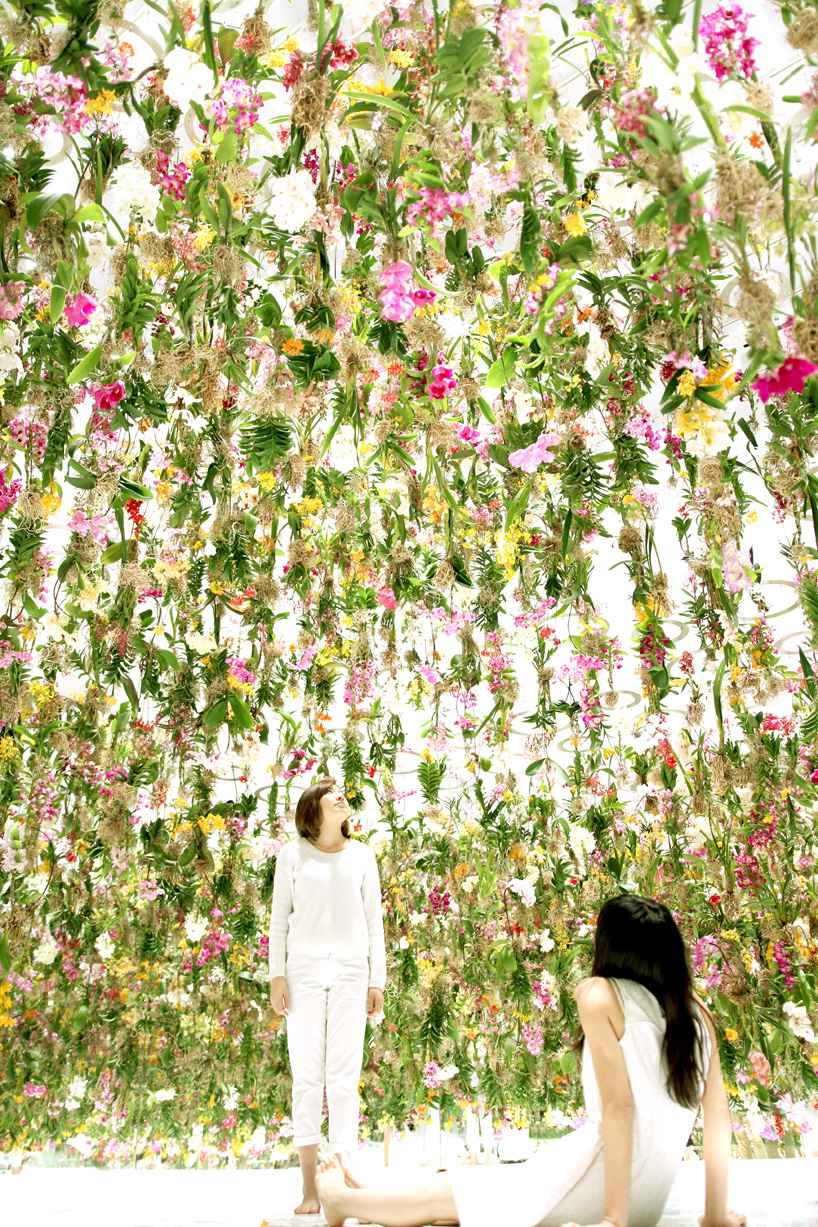
teamlab
チームラボ
floating flower garden
“Much as Random International’s “Rain Room” allowed visitors to walk through the rain without getting wet, “Floating Flower Garden” is designed so that viewers can walk through a hanging garden without getting … flowered. Sensors that detect an approaching viewer cause flowers in that viewer’s vicinity to rise.” Kriston Capps

DANIEL PALACIOS
Waves
FILE FESTIVAL
A long piece of rope generates 3D waves floating in space by the physical action of its movement: the rope which creates the visual waves also simultaneously creates the sound by cutting through the air, making up a single element. The installation is affected by those who watch it. When the audience moves around it they influence the movements of the rope, generating visual and acoustic sound waves from harmonic patterns to complex ones.

GREYWORLD
The Source
The Source, an eight storey high kinetic sculpture, is the new symbol for the London Stock Exchange. Every morning, millions of viewers around the world will watch the installation come to life, signifying the opening of the London Markets.
“The Source is formed from a grid of cables arranged in a square, 162 cables in all, reaching eight stories to the glass roof. Nine spheres are mounted on each cable and are free to move independently up and down its length. In essence the spheres act like animated pixels, able to model any shape in three dimensions a fluid, dynamic, three dimensional television.Visitors to the atrium are greeted by this motion: its particles rising and falling, generating an infinite range of figurative and abstract shapes that rise, dissolve and reform at different heights in the atrium. The shape of the sun rising on a new day of trade, the names and positions of currently traded stocks, the DNA helix at the center of life formed by the work, and floating in the 32m void of the atrium.”

steven meisel
Стивен Майзель
ستيفن ميزل
史蒂芬迈泽尔
스티븐 마이젤
סטיבן מייזל
スティーヴン・マイゼル
Floating
Steven Meisel nació en Nueva York en 1954 y estudió en la Parsons School of Design. Prolífero e innovador, Meisel ha influenciado tendencias en el mundo de la moda durante más de 20 años, con campañas de publicidad para Prada, Dolce & Gabbana, Valentino y Versace… entre otras marcas.

George Balanchine
The Nutcracker
Waltz of the Flowers
New York City Ballet
“You don’t think of choreographers as mathematicians — yet group dances involve arithmetic and geometry. Nobody mastered those aspects of the art more brilliantly than George Balanchine.
See what he does with the “Waltz of the Flowers” in “The Nutcracker,” as in this short detail:As it begins, 14 women, arrayed in four rows, face front. The two demi-soloists start: They dance from our right to left, with two turning jumps at the end of the phrase. Then a row of four women behind them take up the same phrase — but now the first two women repeat the phrase in the opposite direction, from left to right.It’s like seeing screens sliding in opposite directions. Then the next row takes it up; then the next; suspense and excitement build. It’s an accumulating canon — not spread out across the stage but at close quarters”. Alastair Macaulay

David Lynch
Дэвид Линч
ديفيد لينش
大卫·林奇
デビッドリンチ
데이비드 린치
Дэвид Линч
Eraserhead
The Man in the Planet (Jack Fisk) pulls levers in his home in space, while the head of Henry Spencer (Jack Nance) floats in the sky. A giant spermatozoon-like creature emerges from Spencer’s mouth, floating into the void. The Man in the Planet appears to control the creature with his levers, eventually making it fall into a pool of water.
cinema

Byoungho Kim
Бйонхо Киму
Floating Land
Este artista nacido y establecido en Seul trabaja con esculturas muy visuales que a veces rozan la linea que separa la escultura de la máquina. En muchas de ellas investiga con las posibilidades del sonido convirtiéndolo en arte. El artista surcoreano califica su obra como “Fantasía construida, fantasía del deseo, y una fantasía de nuestro tiempo”. Byoungho Kim dice que “la humanidad está en la búsqueda continua de nuevos deseos” y esa es una buena reflexión que también puede definir su obra a la perfección.

Gavin Munro
The Floating Green Chair
The founder of Derbyshire, England-based Fully Grown, says the idea of creating “living furniture” came to him at a young age when he stumbled upon a bonsai tree that resembled a chair. Though it took another 25 years before Munro began to morph trees into furniture and an additional eight for his vision to become a reality, he never gave up.
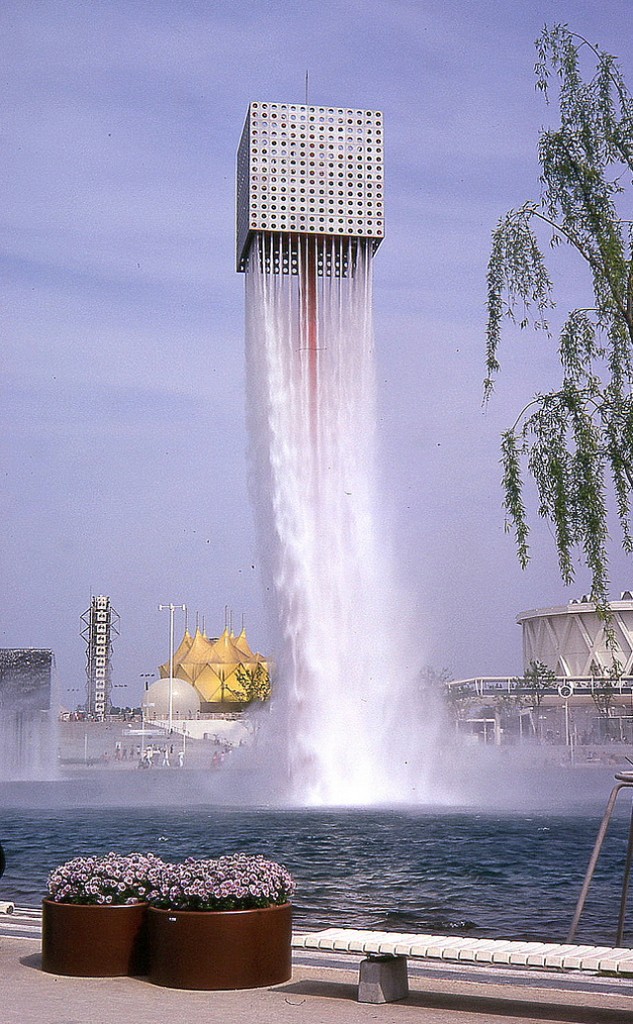
ISAMU NOGUCHI
Исаму Ногучи
イサム·ノグチ/
איסמו נוגוצ’י/
이사 무 노구치
野口勇
ايسامو نوغوشي
Nine floating Fountains
Đài phun nước có thiết kế độc đáo này nằm tại Osaka, Nhật Bản. Được xây dựng năm 1970 đài phun nước Floating là kiệt tác cuối cùng mà Kiến trúc sư Isamu Noguchi dành cho hội chợ triển lãm quốc tế tại Osaka, Nhật Bản.

LEIMAY: Ximena Garnica & Shige Moriya
Floating Point Waves
Floating Point Waves is an environment of strings, water, solo performance, real-time video, and live electronic music that unveils the relationship between the human body and natural elements. Movement, water, and light respond to one another as an organic causal chain unfolds, echoing that of our own natural world. Startling performance and exquisite design reverberate through the space, framing a landscape where beauty coexists with darkness.
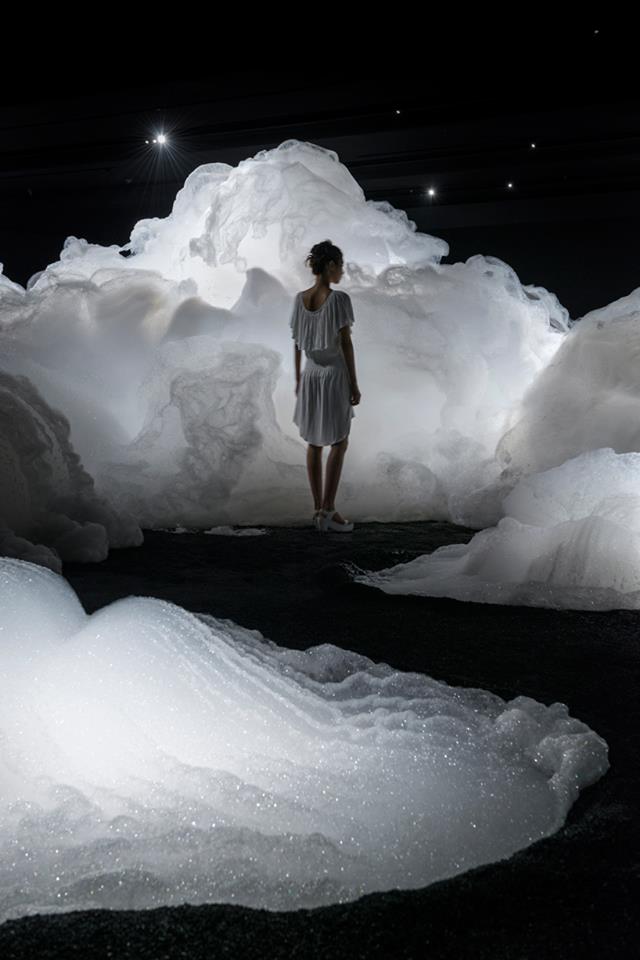
KOHEI NAWA
كوهي ناوا
名和晃平
КОХЕЙ НАВА
foam
Japanese artist Kohei Nawa has immersed visitors at the aichi triennale in undulating sea of bubbling matter, surrounding the walls and floor in porous, cloud-like material. ‘Foam’ inhabits an almost pitch-black room, creating an ethereal quality that seems aesthetically otherworldly walking through the space, the topography of the puffs creates a massive terrain of floating material, stiff enough to stand in place, yet copious in its fragility and delicacy.

Isabel Berglund
Floating Island of Pearls
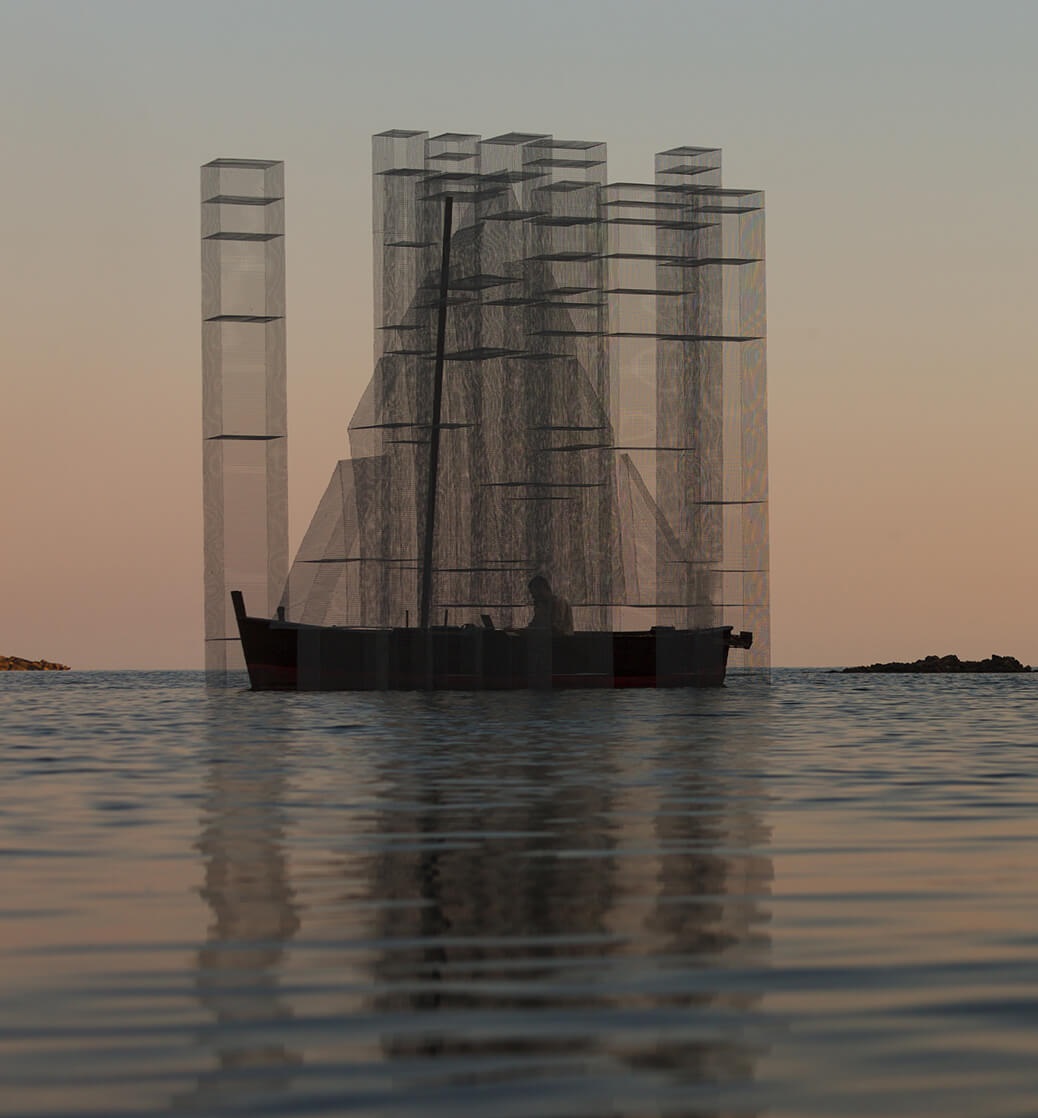
edoardo tresoldi
floating musical performance
with IOSONOUNCANE


TACITA DEAN
Turbine Hall
The Turbine Hall of Tate Modern is plunged into deep black gloom. At its east end, like the stained glass window of a cathedral, is a giant vertical screen. It is framed at the edges with sprocket holes, so we feel we are looking at a vast reel of film. In the centre, an ever-changing series of images: a snail on a wind-wobbled leaf, the powerful spume of a fountain, a chimney loosing trails of vapour. Sometimes the image is of the back wall of the Turbine Hall itself, but with its gridded form coloured in red, yellow and blue so it resembles a Mondrian. Or with a giant egg apparently floating from ceiling to floor.
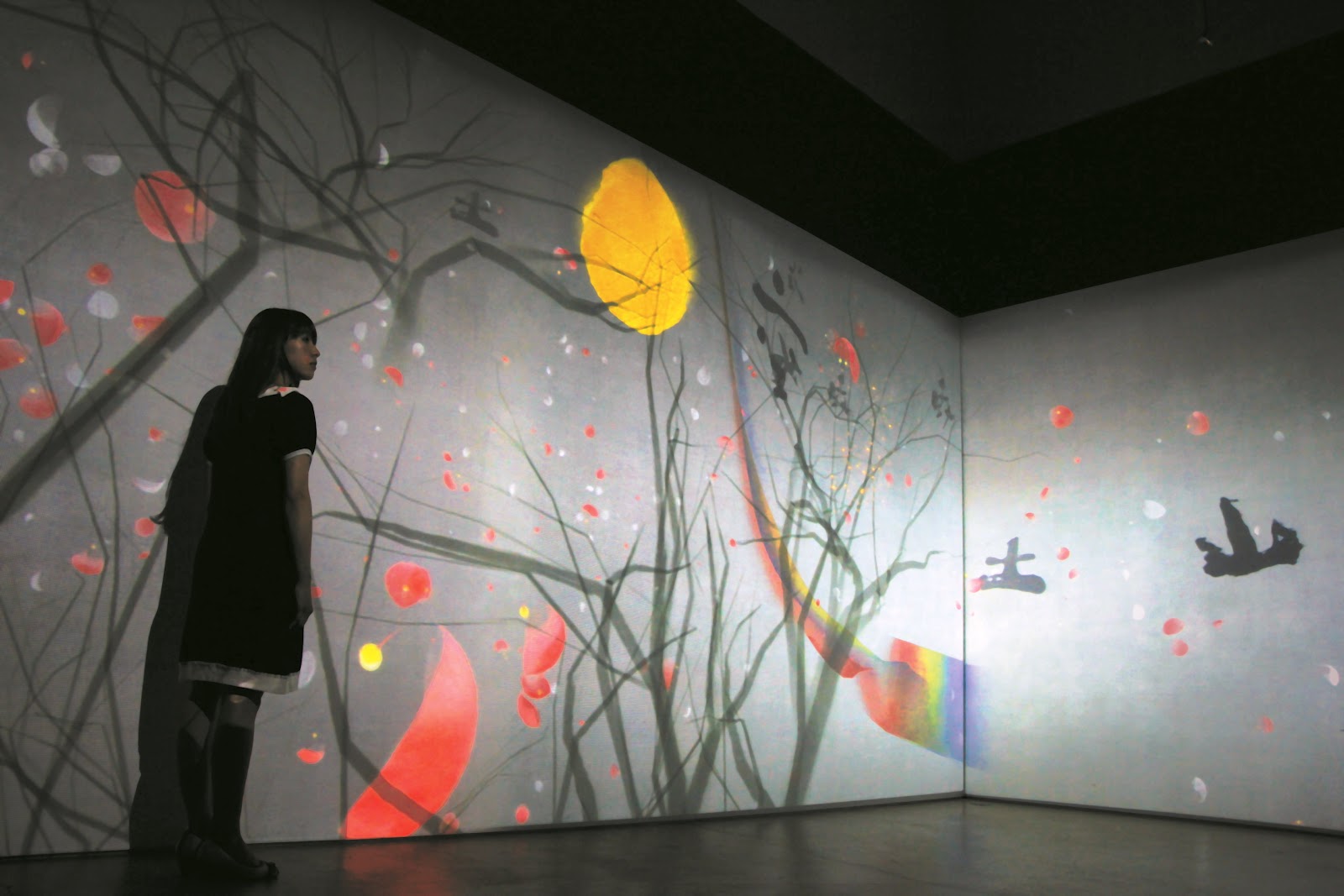
SISYU+teamLab
What a Loving and Beautiful World
file festival
In the current digital age, digital media is part of our everyday life. So this participatory installation inserts calligraphy by Sisyu into a digital media art work that gives people the chance to enjoy calligraphy in a new way. The calligraphy is projected onto a large wall and the sho (Japanese calligraphic characters) appear to be sucked into the shadow of the person participating. This action causes a series of enchantingly beautiful and vivid visual and sound effects. The floating sho characters on the wall react to one’s shadow and open up to reveal each character’s world. A new world is created by overlapping and combining the sho’s world with that of Sisyu, the calligrapher, one’s own thoughts, and the thoughts of humankind that are contained in the origins of the characters. This work uses a sensor that reads a participant’s action. If a viewer holds their hand against the character for “rainbow”, a rainbow’s image will be produced; if the character is “umi”, which means “ocean”, a wave’s image will be created. Each visual reacts with other visuals allowing for an infinite number of variations.



OTA+
Taipei Museum of Contemporary Art
This building proposal challenges the traditional definition of a museum and the conventional relationship between building and site. The ground floor of the building is reduced to a nominal footprint, enclosing only enough space for basic services, structure and ticketing functions. The ground plane is primarily reserved for exterior public space, including an art park, Hall of Fame, and garden walk. The bulk of the program and building mass are split by the open ground floor. Half of the building is coupled with the earth while the other half hovers in the air. The purpose is twofold; to minimize the damaging effects of extreme local weather by harnessing environmental flows toward productive outcomes and to re-conceptualize the identity of a modern art museum. The manicured roof plane of the below ground program is pocketed with water absorbing vegetation and catchment systems, while the hovering museum above expands to form open atriums, allowing diffuse light to brighten the space and passive airflow to comfortably condition the building.The program of the museum is interconnected. The Contemporary Museum of Art, Children’s Museum of Art and Administration are located within the floating mass. The lecture hall, parking, art resource center, library and classrooms are located below ground. The programs below ground are easily accessible and directly connected through vertical circulation tubes, providing both structural support for the floating mass above and space for movement systems, such as escalators, stairs and elevators between levels. All of the below ground programs are flooded with diffuse light passing through skylights that penetrate the landscape.


